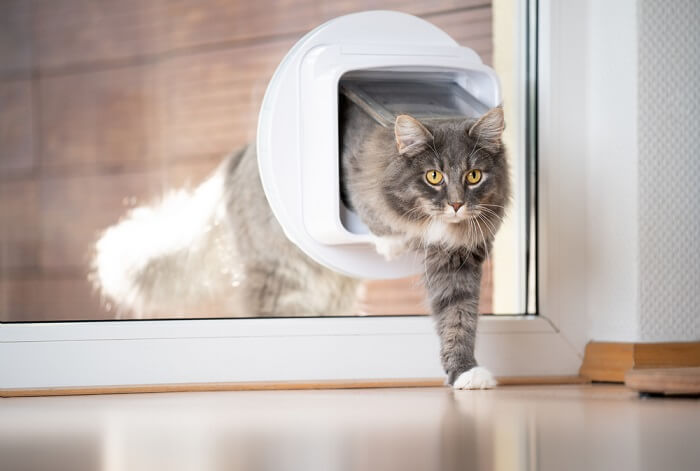
Any cat owner knows that feline people are naturally curious, and when it comes to exploring the outdoors, this is no exception! If your cat has access to the outside, you may wonder where they go when they leave your property boundary and why they choose to do this.
Cats roam for a vast number of reasons, and this behaviour cannot be prevented entirely unless a cat is kept indoors. A recent large study found the average “home range” for domestic cats is small, at around 3.6 (+/- 5.6) hectares. To be healthy and happy, indoor-only cats must have their physical and behavioural needs met. Speak to your veterinarian for more advice if needed.Key Takeaways
Why Do Cats Roam Away From Home?
When cats have access to the outdoors, they may choose to roam for many reasons, including:
1. Mating Behavior
The mating drive in female and intact male cats is powerful. When they come into heat, female cats are likely to wander to look for a mate, and indoor-only cats may even try to escape the house to look for a suitor. Intact male cats will also actively travel in search of a mate.
2. Hunting Behavior
The hunting drive is instinctual for most cats, even if they are well-fed at home. Some cats may wander surprising distances when seeking small prey animals to hunt.
3. Cheating
While we like to think our cat only has eyes for us, actually, cats can sometimes be quite fickle creatures! If your neighbour offers tasty treats or a comfy sleeping spot, you may find your cat roaming to a new home as much as daily.
4. Stress
Cats are susceptible to stress, and even mild environmental changes can cause them to feel uncomfortable. If something new and stressful for your cat happens at home, such as a renovation project, a new baby, or a puppy, your cat may choose to spend more time away from home.
5. Neglect
While we are sure our readers at Cats.com would never fall into this category, some cats sadly live in neglectful homes. Where possible, if a cat is experiencing neglect or ill-treatment, they may roam away from home or even move out.
6. Giving Birth

Cats often choose a warm, dark and quiet space in which to give birth
Pregnant cats crave a safe environment to have their kittens. If the home environment is busy, loud, or stressful, your cat may roam from home to find somewhere more suitable to have her babies.
7. Sickness
When a cat is feeling unwell, they naturally will hide away. This behavior results from domestic cats having predators of their own, and feeling unwell puts a cat at risk of being hunted. Sadly, when some cats feel poorly, they may wander away from home to hide.
Therefore, if you suspect something is wrong with your cat, it is best to keep them inside and have them checked by your local veterinarian.
8. Getting Lost or Moving House
Sometimes, especially if a cat is in a new environment, they may wander away simply because they do not have a good sense of direction in this new place. This can especially be true when you just moved house with your cat.
It is advisable to keep your cat indoors for the first three or so weeks after a house move so they can familiarise themselves with and settle into their new home. If your cat is lost, let your local veterinarian and animal shelter know. Consider using social media to help in your search.
How Far Do Cats Roam From Home?
Several studies have been performed using GPS trackers, and it has been found that the distance cat travels away from home (their range) is dependent on many factors, including:
1. Urban, Suburban, or Rural Environment

Cats in more rural environments may have larger territories
One study found cats living near natural areas have a more extensive range, while another documented that cats living in areas of higher housing density will have a smaller range.
2. Gender
On average, male cats have been documented to roam further than female cats.
3. Cat Population Density
It has been found that cats living in a region of higher cat population density (i.e., more cats in a certain amount of space) will have a smaller range.
4. Neutering Status
Both male and female cats will roam in pursuit of a sexual partner. Interestingly, the Hall et al., (2016) study did not find a significant effect of neutering status on a cat’s home range size.
This study did suggest that if a cat is neutered before sexual maturity, their home range is likely to be smaller. A more recent study, however, found that intact cats roam further, so more research is needed to get to the bottom of this!
5. Age

Young cats are often highly curious and exploratory in nature
Younger cats (those less than eight years old) have been found to have a more extensive range than older cats.
Interestingly, husbandry (pet cats vs. feral farm cats, for example) did not seem to impact range in the large-scale study of roaming behavior.
Roaming Distances
As a result of all these impacting variables, it is not easy to give a definitive distance when it comes to cats roaming behavior.
Still, a recent study of 925 cats in six countries found domestic cats tend to have small home ranges of around 3.6 (+/- 5.6) hectares, about 0.01 square miles. If you are curious to see where your cat roams, consider using a cat-safe GPS collar!
How Can I Stop My Cat From Roaming?
There are many reasons you may wish to stop your cat from roaming. Perhaps you live near a busy highway or in an area with known predators such as coyotes. There are several ways to help limit roaming behavior in domestic cats:
1. Neutering
One of the main recommendations for limiting roaming behavior in both male and female cats is to have them neutered, but it should be noted that neutered cats may well still roam. Mating behaviour is only one reason for this behavior.
It is advisable to keep your cat indoors until they have been neutered. Female cats are capable of pregnancy from as young as four months old.
2. Keeping Indoors
A straightforward way to prevent your cat from roaming away from home is to keep them indoors. Indoor-only cats need to be provided with an appropriate environment to meet their physical and mental needs and plenty of mental stimulation through play and cuddle time to be happy.
Cats who do not have these needs met can develop significant medical and behavioral problems due to stress. Therefore, if you are unsure if you can keep a cat happy indoors, it is important to speak to your veterinarian for advice.
Not every cat, even with the very best management, will be happy in an indoor-only environment, especially if they have lived a nomadic or outdoorsy lifestyle in the past. Indoor cats sometimes escape, which can be a massive worry for any cat parent. Read our article on what to do if your indoor cat escapes here.
3. Catio
If you like the idea of your cat having access to the outdoors but do not want to risk them free-roaming, installing a catio or enclosed exercise pen can be helpful. This is only an option for pet owners with access to their own outdoor space.
Also Read: Best Cat Window Seat & Perches
How Can I Train My Cat To Come Home?

Cats can respond well to basic training, such as litter training and use of a cat flap
There are several things you can do to help train your cat to find their way home, which include:
- Teaching them to come when called
- Leaving out familiar scents
- Calling them in at appropriate times (cats are most active at dawn and dusk)
- Rattle their favourite treats
- Installing a cat flap
Do not chase your cat to try and catch them. They will outrun you, and they may be less willing to come home if you frighten them. Always ensure your cat has a microchip and consider a cat tracker or similar tracking devices.
Final Thoughts
Roaming is the result of many different natural behavioral drives in our cats. The distance a cat may roam is affected by many variables, and while there are things you can do to help limit this behavior, it cannot be prevented. Even regularly fed pet cats will wander from home.
Therefore, if you live in an area where roaming behavior may be dangerous to your kitty, it may be best to keep them indoors. Your veterinarian can advise making indoor life as stress-free as possible.
Related Symptoms
Frequently Asked Questions
How far do cats roam in a day?
How far a cat roams is affected by where they live, their gender, whether they are neutered, and how domesticated they are. On average, it is reported domestic cats will have a range of around 3.6 (+/- 5.6) hectares, but many cats may roam much further than this.
Why do cats roam?
Cats roam for many reasons, including searching for a mate, searching for food, stress, pregnancy, and illness, amongst many others.
What is the farthest a cat has roamed?
While no official verified record is held, there is a report of a cat called Jessie travelling 1900 miles from the Northern Territory to Ungarra in Australia! While this isn’t proven, there are many reports of cats travelling hundreds of miles to get back to their old homes.
-
Hall. C et al. (2016) Factors determining the home ranges of pet cats: A meta-analysis. Biological conservation. 203 313-320 DOI https://doi.org/10.1016/j.biocon.2016.09.029
-
Kays et al. (2021) The small home ranges and large local ecological impacts of pet cats. Animal Conservation 23 516-523 DOI https://doi.org/10.1111/acv.12563
-
Pirie et al. (2022) Pet cats (Felis catus) from urban boundaries use different habitats, have larger home ranges and kill more prey than cats from the suburbs. Landscape and Urban Planning. 220 DOI https://doi.org/10.1016/j.landurbplan.2021.104338







